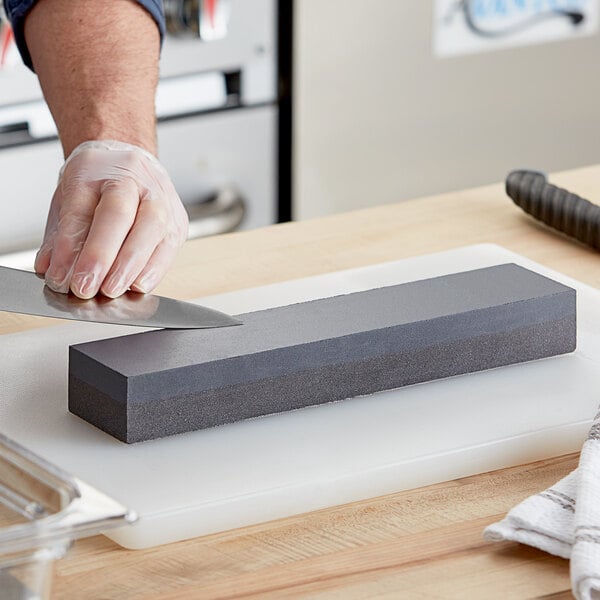Sharpening a Knife With a Stone

To sharpening a knife with a stone, place the stone on a stable surface and hold the knife at a 20-degree angle. Gently slide the blade across the stone in a sweeping motion, ensuring even contact.
Sharpening a knife with a stone is a fundamental skill that ensures your knives remain effective and safe to use. Whether you’re a culinary enthusiast or an outdoor adventurer, a sharp knife is essential for precise cutting and overall efficiency.
By mastering the technique of using a sharpening stone, you can prolong the life of your knives and maintain their cutting edge. In this guide, we’ll explore the step-by-step process of sharpening a knife with a stone, as well as the benefits of this traditional method. Whether you’re a beginner or looking to refine your sharpening skills, this guide will equip you with the knowledge to achieve optimal results.
:max_bytes(150000):strip_icc()/__opt__aboutcom__coeus__resources__content_migration__serious_eats__seriouseats.com__images__20100423-sharpening20-2004-aba6e6fa129844a7a106fa006eb98c3d.jpg)
The Art Of Knife Sharpening
Knife sharpening is an essential skill for maintaining kitchen tools. Using a stone is a traditional method that requires precision and patience. The process involves using different types of stones, such as whetstones, to achieve a razor-sharp edge. Proper sharpening ensures the knife’s longevity and improves its performance. A sharp knife enhances safety, efficiency, and the overall cooking experience.
Types Of Sharpening Stones
Sharpening a knife with a stone requires the right type of sharpening stone. There are various types of sharpening stones available, including oil stones, water stones, and diamond stones. Each type has its unique characteristics and is suitable for different sharpening needs.
| Water Stones | Provide a keen edge with regular soaking. |
| Oil Stones | Require oil for lubrication during use. |
| Diamond Stones | Known for their durability and long lifespan. |
| Ceramic Stones | Produce sharp blades and are low-maintenance. |
Selecting The Right Stone
Grit sizes explained: The first step in sharpening a knife with a stone is selecting the right one. The grit size determines the coarseness or fineness of the stone. A lower grit number, such as 200, is more coarse, whereas a higher number, such as 1000, is finer. For a dull knife, use a lower grit stone and progress to a higher grit for a sharper edge.
Matching stone to knife type: Different types of knives require different types of stones. A softer steel knife, such as a Japanese knife, requires a finer grit stone, whereas a harder steel knife, such as a German knife, requires a coarser grit stone. It is important to match the stone to the knife type to achieve the best sharpening results.
| Knife Type | Stone Type |
|---|---|
| Japanese Knife | 1000-6000 grit stone |
| German Knife | 200-1000 grit stone |
Preparing Your Sharpening Stone
To prepare your sharpening stone, you need to follow two steps: soaking water stones and lubricating oil stones. Soaking water stones is essential before using them. It helps to prevent the stone from absorbing too much water while sharpening. Simply place the stone in a container filled with water and let it soak for the recommended time. Lubricating oil stones is necessary to enhance their sharpening performance. Apply a few drops of honing oil or mineral oil onto the stone’s surface, spreading it evenly. This will create a lubricated surface for smoother sharpening. By properly preparing your sharpening stone, you can ensure optimal results when sharpening your knife.
Sharpening Techniques
When sharpening a knife with a stone, it’s crucial to find the correct angle. This can be achieved by holding the blade at a consistent angle during the sharpening process. Consistency is key to achieving a sharp edge, so maintain a steady hand and apply even pressure. Start by finding the angle that works best for your knife, and then proceed with the sharpening process. Be patient and take your time to ensure that the blade is sharpened evenly. Remember, a well-sharpened knife is a valuable tool in the kitchen or any other setting where precision cutting is required.

Common Sharpening Mistakes
Avoid common sharpening mistakes when using a stone to sharpen a knife. Ensure brief, clear sentences and vary your phrases to keep the reader engaged. Optimize your content for SEO and write in an active voice for a natural, human-like tone.
| Common Sharpening Mistakes |
| Applying Too Much Pressure can damage the knife edge. |
| Inconsistent Angles result in uneven sharpening and reduced effectiveness. |
| Neglecting Stone Maintenance leads to poor sharpening results over time. |
Testing Knife Sharpness
Testing knife sharpness can be done using various methods:
- The paper test involves cutting a piece of paper with a knife. A sharp knife will cut through the paper effortlessly while a dull knife will tear the paper.
- The tomato test involves slicing a tomato with a knife. A sharp knife will cut through the tomato smoothly without squishing it while a dull knife will struggle and squish the tomato.
- Visual inspection involves examining the blade for any nicks or chips. A sharp knife will have a smooth and even edge without any imperfections.
Sharpening a knife with a stone is a skill that requires practice and patience. Testing the sharpness of the knife is important to ensure it is safe and efficient to use.
Maintaining Your Sharpening Stone
After sharpening your knife, it’s important to take care of your sharpening stone to ensure its longevity. Cleaning your stone after use is crucial to prevent the buildup of metal shavings and other debris. Simply use a soft-bristled brush and warm water to remove any residue.
Flattening your stone is also important to maintain its effectiveness. This can be done with a flattening stone or diamond plate. Gently rub the flattening tool against the sharpening stone until it’s even and flat.
| Storage Solutions |
|---|
| Store your sharpening stone in a dry place to prevent it from rusting or developing mold. |
| Avoid storing your stone with other tools or in a container that doesn’t allow for proper ventilation. |
Advanced Sharpening Tips
To address nicks and chips, use coarse stone grit. Follow up with finer grit for a smoother edge. Stropping helps achieve a polished knife edge. Professional sharpening is advisable for complex issues.

Frequently Asked Questions
What Is The Proper Way To Use A Knife Sharpening Stone?
To properly use a knife sharpening stone, follow these steps: 1. Wet the stone with water or oil. 2. Hold the knife at a 20-degree angle against the stone. 3. Draw the blade back and forth across the stone, using light pressure.
4. Repeat on the other side until the blade is sharp. 5. Rinse the knife and stone with water and dry them.
Do You Wet A Stone Before Sharpening A Knife?
Yes, wetting the stone before sharpening a knife helps create a smoother sharpening surface.
Do You Push Or Pull When Sharpening Knives With Stone?
When sharpening knives with a stone, always push the knife away from you. This helps maintain a consistent angle and prevents injury.
Can You Sharpen A Knife With Just A Stone?
Yes, you can sharpen a knife with just a stone. Use the stone to restore the blade’s sharpness.
Conclusion
Sharpening a knife with a stone is a time-honored technique that offers numerous benefits. By following the proper steps, you can achieve a razor-sharp edge that enhances your cutting experience. It is a cost-effective and sustainable method that allows you to maintain your knives’ longevity.
So, next time you need to sharpen your knife, consider using a stone for a satisfying and effective result.






